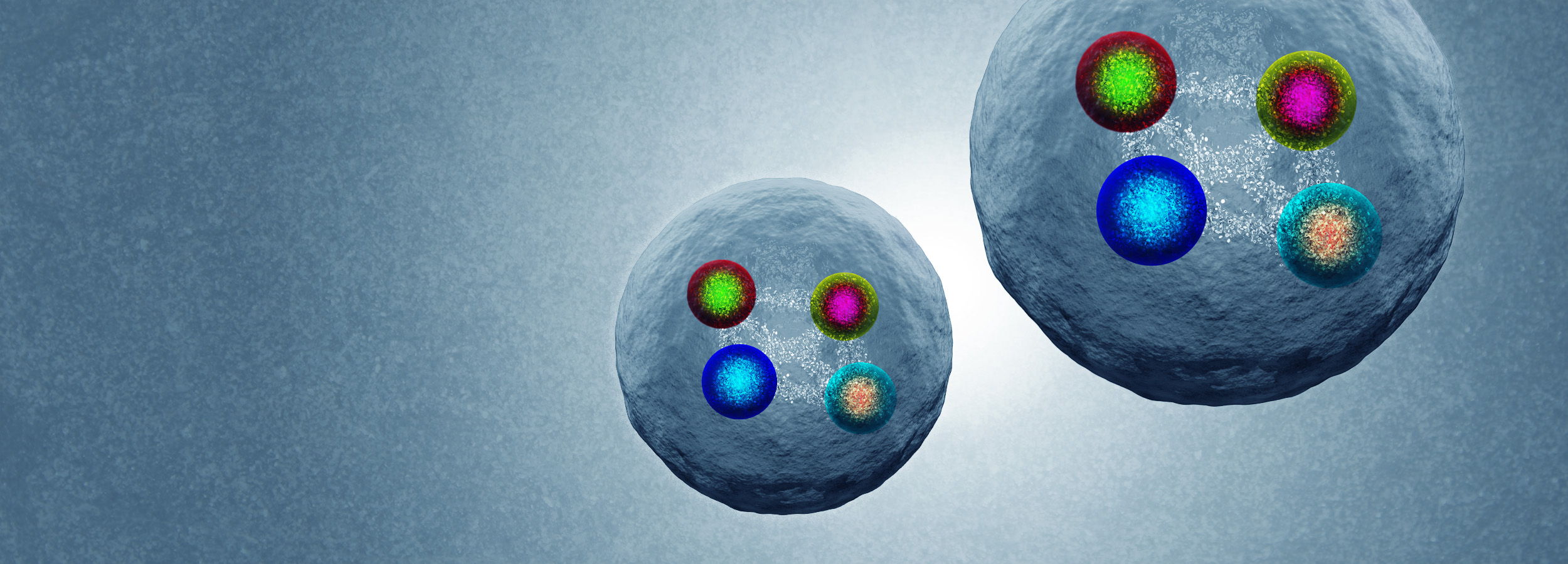ATLAS observes potential four-charm tetraquark
9 July 2022 | By
In the 1960s, physicists Gell-Mann and Zweig independently proposed the existence of the subatomic particles known as quarks. Their model successfully described the particles that interact through the strong force – hadrons – as being made of two or three quarks. At the same time, theorists also predicted the existence of exotic hadrons with more than three quarks, whose properties would not fit the quark model of conventional hadrons.
The X(3872) tetraquark, discovered by the Belle experiment in 2003, was the first such exotic state to be observed. This was followed by a series of tetraquark candidates observed by several experiments. As hadron properties are very hard to predict, the study and detection of exotic hadrons enables physicists to obtain new understandings of the strong force at low energy scales.
In 2020, a possible tetraquark with mass of about 6.9 GeV was observed by the LHCb experiment in the study of J/ψ meson pairs in the four-muon final state. The particle, called X(6900), is an exotic hadron which may consist of two charm quarks and two charm antiquarks in a bound state. X(6900) was observed as a narrow peak in the four-muon mass spectrum, alongside a broad structure whose nature remains unclear. This structure may be related to other decay channels such as J/ψ+ψ(2S), which have not been studied. The ψ(2S) meson is an excited resonant state of J/ψ. The advantage of these kinds of fully-heavy tetraquarks (i.e. with “heavy” bottom or charm quarks) is their simplified theoretical calculations, easing the comparison with experiments.
In a new analysis presented at the ICHEP 2022 conference, ATLAS physicists found evidence of a four-charm-quark (also called “di-charmonium”) excess. For their analysis, researchers studied both the J/ψ pair and J/ψ+ψ(2S) decay channels in events with four muons in the final state using the full Run-2 dataset.
This result was achievable thanks to ATLAS’ excellent muon identification system and its dedicated B-physics event selection system. This allowed researchers to comb through a huge amount of low-momentum data to select four-muon signal events with high purity for physics analysis. Physicists reconstructed the di-charmonium candidates using two pairs of opposite charge di-muons, whose inner detector tracks originate from a common vertex. To obtain the best mass resolution, researchers set constraints on the mass of the di-muons. They also employed a combination of Monte Carlo simulations and data-driven methods to estimate the various background processes.
ATLAS found a significant excess of data over the total background in the mass spectrum of J/ψ pairs (see figure). Like LHCb, both X(6900) and a broad structure at threshold are seen. The combined significance is far above the 5 standard derivations required for a discovery. A model of three interfering resonances describes the spectrum well. An excess composed of two structures with a significance of 4.6 standard deviations is also seen in the J/ψ+ψ(2S) channel. One of them could be related to X(6900) in the J/ψ pair channel, and the other has a resonance mass at about 7.2 GeV. Researchers also tested the possibility of a single structure with a broad width.
More data are needed to understand the nature of these resonances and structures. For example, other resonances could contribute to the broad structures. If the excess in the J/ψ+ψ(2S) channel is fully confirmed, its feed down to the J/ψ pair channel should also contribute to the threshold structure. Data from the upcoming LHC Run 3 will allow physicists to better study interesting properties of these resonances.
Learn more
- Observation of an excess of di-charmonium events in the four-muon final state with the ATLAS detector (ATLAS-CONF-2022-040)
- ICHEP 2022 presentation by Evelina Bouhova-Thacker: ATLAS results on exotic hadronic resonances
- Belle Collaboration: Observation of a narrow charmonium-like state in exclusive B±→K±π+π− decays (Phys. Rev. Lett. 91 (2003) 262001, arXiv: hep-ex/0309032)
- Non-Standard heavy mesons and baryons: Experimental evidence (Rev. Mod. Phys. 90 (2018) 015003, arXiv: 1708.04012)
- LHCb Collaboration: Observation of structure in the J/ψ pair mass spectrum (Science Bulletin 65 (2020) 1983, arXiv: 2006.16957)
- See also the full lists of ATLAS Conference Notes and ATLAS Physics Papers.






